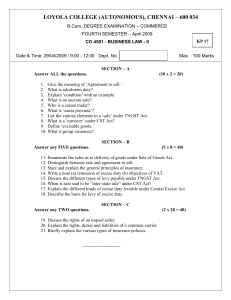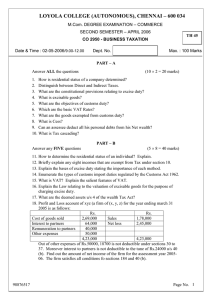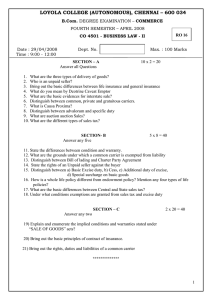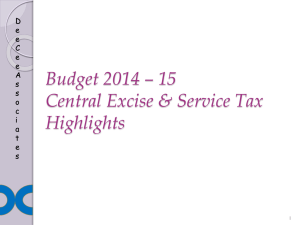IJMRA-3482
advertisement
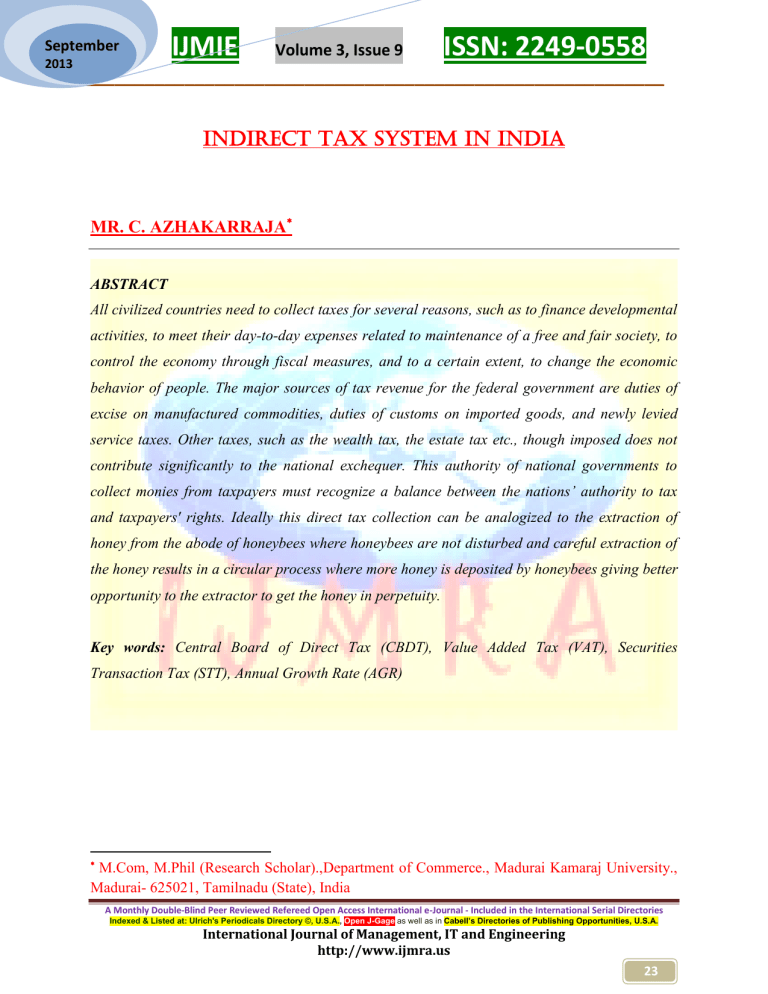
September 2013 IJMIE Volume 3, Issue 9 ISSN: 2249-0558 __________________________________________________________ INDIRECT TAX SYSTEM IN INDIA MR. C. AZHAKARRAJA ABSTRACT All civilized countries need to collect taxes for several reasons, such as to finance developmental activities, to meet their day-to-day expenses related to maintenance of a free and fair society, to control the economy through fiscal measures, and to a certain extent, to change the economic behavior of people. The major sources of tax revenue for the federal government are duties of excise on manufactured commodities, duties of customs on imported goods, and newly levied service taxes. Other taxes, such as the wealth tax, the estate tax etc., though imposed does not contribute significantly to the national exchequer. This authority of national governments to collect monies from taxpayers must recognize a balance between the nations’ authority to tax and taxpayers' rights. Ideally this direct tax collection can be analogized to the extraction of honey from the abode of honeybees where honeybees are not disturbed and careful extraction of the honey results in a circular process where more honey is deposited by honeybees giving better opportunity to the extractor to get the honey in perpetuity. Key words: Central Board of Direct Tax (CBDT), Value Added Tax (VAT), Securities Transaction Tax (STT), Annual Growth Rate (AGR) M.Com, M.Phil (Research Scholar).,Department of Commerce., Madurai Kamaraj University., Madurai- 625021, Tamilnadu (State), India A Monthly Double-Blind Peer Reviewed Refereed Open Access International e-Journal - Included in the International Serial Directories Indexed & Listed at: Ulrich's Periodicals Directory ©, U.S.A., Open J-Gage as well as in Cabell’s Directories of Publishing Opportunities, U.S.A. International Journal of Management, IT and Engineering http://www.ijmra.us 23 IJMIE September 2013 Volume 3, Issue 9 ISSN: 2249-0558 __________________________________________________________ Introduction India is common law of federal country, with separation of powers between the legislature, the judiciary and the executive. There is a division of legislative powers between states and the federation itself under article 246 of the Constitution. Each state has its own executive government, which functions independently from the federal government. Taxes consist of indirect taxes, and may be paid in money or as its labor equivalent. India has a well developed taxation structure. The tax system in India is mainly a three tier system which is based between the Central, State Governments and the local government organizations. The Central Excise Department spread over the entire country administers and collects the central excise duty. The apex body that is responsible for the policy and formulation of rules is the Central Board of Excise and Customs which functions under the control of the Union Finance Ministry. The Central Excise officers are also entrusted with the administration and collection of Service tax, Customs duty and other indirect taxes. Objectives of the Study To study on Major Indirect Taxes To overview an Indirect Taxes Sub System To compute Indirect Taxes Annual Growth Rate Analysis of Annual Growth Rate Research Methodology Secondary Data are used in this research study. This study secondary data are collecting from books, journals, reports and internet, magazines. Tools Used Tools are used in calculations of Annual Growth Rate in the Formula are used: AGR = CY – PY / PY * 100 Where, AGR = Annual Growth Rate, CY = Current Year, PY = Previous Year. Note- 1. All Table Source in Indian Public Finance Statistics Year of 2010-2011 and 2011-2012. Important Indirect Taxes in India A Monthly Double-Blind Peer Reviewed Refereed Open Access International e-Journal - Included in the International Serial Directories Indexed & Listed at: Ulrich's Periodicals Directory ©, U.S.A., Open J-Gage as well as in Cabell’s Directories of Publishing Opportunities, U.S.A. International Journal of Management, IT and Engineering http://www.ijmra.us 24 September 2013 IJMIE Volume 3, Issue 9 ISSN: 2249-0558 __________________________________________________________ An indirect tax is a tax collected by an intermediary (such as a retail store) from the person who bears the ultimate economic burden of the tax (such as the customer). An indirect tax is one that can be shifted by the tax payer to someone else. An indirect tax may increase the price of a good so that consumers are actually paying the tax by paying more for the products. The some important indirect taxes in India are as under: Customs Duty: The Customs Act was formulated in 1962 to prevent illegal imports and exports of goods. Besides, all imports are sought to be subject to a duty with a view to affording protection to indigenous industries as well as to keep the imports to the minimum in the interests of securing the exchange rate of Indian currency. Duties of customs are levied on goods imported or exported from India at the rate specified under the customs Tariff Act, 1975 as amended from time to time or any other law for the time being in force. CUSTOMS DUTY ANNUAL GROWTH YEAR (RS. In Crore) RATE (%) 2002-2003 44851.62 2003-2004 48629.22 8.4224 2004-2005 57610.9 18.4697 2005-2006 65067.14 12.9424 2006-2007 86327.24 32.6741 2007-2008 104118.94 20.6096 2008-2009 99878.86 -4.0723 2009-2010 83323.71 -16.5752 2010-2011 131800 58.1783 2011-2012 151700 15.0986 AVERAGE 87330.76 16.1942 Table -1: Customs Duty Annual Growth Rate in period of 2003 to 2011 In the year 2008, 2009 Customs Duty collection is not possible, remaining years are as well. Under the custom laws, the various types of duties are leviable: 1. Basic Duty: This duty is levied on imported goods under the Customs Act, 1962. Additional Duty (Countervailing Duty) (CVD): This is levied under section 3(1) of the Custom Tariff Act and is equal to excise duty levied on a like product manufactured or produced in India. If a like product is not manufactured or produced in India, the excise duty that would be leviable on that product had it been manufactured or produced in India is the duty payable. If the product A Monthly Double-Blind Peer Reviewed Refereed Open Access International e-Journal - Included in the International Serial Directories Indexed & Listed at: Ulrich's Periodicals Directory ©, U.S.A., Open J-Gage as well as in Cabell’s Directories of Publishing Opportunities, U.S.A. International Journal of Management, IT and Engineering http://www.ijmra.us 25 September 2013 IJMIE Volume 3, Issue 9 ISSN: 2249-0558 __________________________________________________________ is leviable at different rates, the highest rate among those rates is the rate applicable. Such duty is leviable on the value of goods plus basic custom duty payable. 2. Anti-dumping Duty: Sometimes, foreign sellers abroad may export into India goods at prices below the amounts charged by them in their domestic markets in order to capture Indian markets to the detriment of Indian industry. This is known as dumping. In order to prevent dumping, the Central Government may levy additional duty equal to the margin of dumping on such articles. Protective Duty: Tariff Commission set up by law recommends that in order to protect the interests of Indian industry, the Central Government may levy protective antidumping duties at the rate recommended on specified goods. 3. Export Duty: Such duty is levied on export of goods. At present very few articles such as skins and leather are subject to export duty. The main purpose of this duty is to restrict exports of certain goods. 4. National Calamity Contingent Duty: This duty was imposed under Section 134 of the Finance Act, 2003 on imported petroleum crude oil. This tax was also leviable on motor cars, imported multi-utility vehicles, two wheelers and mobile phones. 5. Education Cess: Education Cess is leviable @ 2% on the aggregate of duties of Customs (except safeguard duty under Section 8B and 8C, Countervailing Duty (CVD) under Section 9 and anti-dumping duty under Section 9A of the Customs Tariff Act, 1985). Customs Duty bound rates under international commitments are exempted from this Cess. Secondary and Higher Education Cess: Leviable @1% on the aggregate of duties of Customs. 6. Road Cess: Additional Duty of Customs on Motor Spirit is leviable and Additional Duty of Customs on High Speed Diesel Oil is leviable by the Finance Act (No.2), 1998. and the Finance Act, 1999 respectively. Surcharge on Motor Spirit: Special Additional Duty of Customs (Surcharge) on Motor Spirit is leviable by the Finance Act, 2002. Central Excise Duty: The Central Government levies excise duty under the Central Excise Act, 1944 and the Central Excise Tariff Act, 1985. Central excise duty is tax which is charged on such excisable goods that are manufactured in India and are meant for domestic consumption. The term "excisable goods" means the goods which are specified in the First Schedule and the Second Schedule to the Central Excise Tariff Act 1985. It is mandatory to pay Central Excise duty payable on the goods manufactured, unless exempted eg; duty is not payable on the A Monthly Double-Blind Peer Reviewed Refereed Open Access International e-Journal - Included in the International Serial Directories Indexed & Listed at: Ulrich's Periodicals Directory ©, U.S.A., Open J-Gage as well as in Cabell’s Directories of Publishing Opportunities, U.S.A. International Journal of Management, IT and Engineering http://www.ijmra.us 26 September 2013 IJMIE Volume 3, Issue 9 ISSN: 2249-0558 __________________________________________________________ goods exported out of India. Further various other exemptions are also notified by the Government from the payment of duty by the manufacturers. UNION EXCISE DUTIES ANNUAL GROWTH YEAR (RS. In Crore) RATE (%) 2002-2003 82309.52 2003-2004 90774.31 10.2841 2004-2005 99125.43 9.1999 2005-2006 111225.56 12.2069 2006-2007 117612.76 5.7426 2007-2008 123611.03 5.1000 2008-2009 108612.78 -12.1334 2009-2010 102991.37 -5.1756 2010-2011 137262.52 33.2757 2011-2012 163549.66 19.1510 AVERAGE 113707.49 8.6279 Table -2. Central Excise Duty Annual Growth Rate in 2003 to 2011 In the year 2008, 2009 Annual Growth Rate is negative value, since tax collecting is very poor. In the remaining year Central Excise Duty is average collected. Various Central Excise Duties are: 1. Basis Excise Duty: Excise Duty, imposed under section 3 of the ‘Central Excises and Salt Act’ of 1944 on all excisable goods other than salt produced or manufactured in India, at the rates set forth in the schedule to the Central Excise tariff Act, 1985, falls under the category of Basic Excise Duty In India. 2. Special Excise Duty: According to Section 37 of the Finance Act, 1978, Special Excise Duty is levied on all excisable goods that come under taxation, in line with the Basic Excise Duty under the Central Excises and Salt Act of 1944. Therefore, each year the Finance Act spells out that whether the Special Excise Duty shall or shall not be charged, and eventually collected during the relevant financial year. 3. Surcharge: (a) Special Additional Duty of Excise on Motor Spirit: This is leviable by the Finance Act, 2002. (b) Surcharge on Pan Masala and Tobacco Products: This Additional Duty of Excise has been imposed on cigarettes, pan masala and certain specified tobacco products, at specified rates in the every Budget. A Monthly Double-Blind Peer Reviewed Refereed Open Access International e-Journal - Included in the International Serial Directories Indexed & Listed at: Ulrich's Periodicals Directory ©, U.S.A., Open J-Gage as well as in Cabell’s Directories of Publishing Opportunities, U.S.A. International Journal of Management, IT and Engineering http://www.ijmra.us 27 IJMIE September 2013 Volume 3, Issue 9 ISSN: 2249-0558 __________________________________________________________ Service Tax: The service providers in India except those in the state of Jammu and Kashmir are required to pay a Service Tax under the provisions of the Finance Act of 1994. The provisions related to Service Tax came into effect on 1st July, 1994. Under Section 67 of this Act, the Service Tax is levied on the gross or aggregate amount charged by the service provider on the receiver. However, in terms of Rule 6 of Service Tax Rules, 1994, the tax is permitted to be paid on the value received. The interesting thing about Service Tax in India is that the Government depends heavily on the voluntary compliance of the service providers for collecting Service Tax in India. SERVICE TAX (RS. In Crore) ANNUAL GROWTH YEAR RATE (%) 2002-2003 4122.21 2003-2004 7890.71 91.4194 2004-2005 14199.98 79.9582 2005-2006 23055.26 62.3612 2006-2007 37597.82 63.0770 2007-2008 51301.8 36.4489 2008-2009 60940.99 18.7892 2009-2010 58422.15 -4.1332 2010-2011 69400.02 18.7906 2011-2012 82000 18.1556 AVERAGE 40893.09 42.7630 Table -3. Annual Growth Rate in Service Tax period of 2003 to 2011 Service Tax year of 2003 is very well because in the year high tax revenue, remaining years of Service Tax collection is medium. In 2009 this tax is not possible. Overall Service Tax mean is Rs. 40893.09 Crore and Annual Growth Rate is 42.76%. Sales Tax: State governments impose sales tax on the first sale of a commodity under the power given to them under entry 54 of the state list of the seventh schedule of the Constitution of India. Sales Tax in India is a form of tax is imposed by the Government on the sale or purchase of a particular commodity within the country. Sales Tax is imposed under both, Central Government (Central Sales Tax) and State Government (Sales Tax) Legislation. Generally, each State follows its own Sales Tax Act and levies tax at various rates. Thus, Sales Tax Acts as a major revenuegenerator for the various State Governments. A Monthly Double-Blind Peer Reviewed Refereed Open Access International e-Journal - Included in the International Serial Directories Indexed & Listed at: Ulrich's Periodicals Directory ©, U.S.A., Open J-Gage as well as in Cabell’s Directories of Publishing Opportunities, U.S.A. International Journal of Management, IT and Engineering http://www.ijmra.us 28 September 2013 IJMIE Volume 3, Issue 9 ISSN: 2249-0558 __________________________________________________________ GENERAL SALES TAX YEAR (RS. In Crore) 2002-2003 83768.12 2003-2004 98001 2004-2005 116234.31 2005-2006 136499.62 2006-2007 162297.08 2007-2008 167731.27 2008-2009 190816.72 2009-2010 231460.92 2010-2011 296240.13 2011-2012 350874.15 AVERAGE 183392.33 Table -4. General Sales Tax Annual Growth Rate in 2003 to 2011 ANNUAL GROWTH RATE (%) 16.9908 18.6052 17.4349 18.8993 3.3483 13.7634 21.3001 27.9871 18.4425 17.4191 All the year (2003 to 2011) Sales Tax revenue is positive, year 2007 is less tax collection and the year 2010 tax revenue is high. Value Added Tax (VAT): From 10th April, 2005, most of the States in India have supplemented sales tax with a new Value Added Tax (VAT). The practice of Value Added Tax (VAT) executed by State Governments is applied on each stage of sale, with a particular apparatus of credit for the input Value Added Tax (VAT) paid. Value Added Tax (VAT) in India classified under the tax slabs are 0% for essential commodities, 1% on gold ingots and expensive stones, 4% on industrial inputs, capital merchandise and commodities of mass consumption, and 12.5% on other items. Variable rates (State-dependent) are applicable for petroleum products, tobacco, liquor, etc. Value Added Tax (VAT) levy will be administered by the Value Added Tax Act and the rules made there-under and similar to a sales tax. It is a tax on the estimated market value added to a product or material at each stage of its manufacture or distribution, ultimately passed on to the consumer. Value Added Tax (VAT), in simple terms, is a multi-point levy on each of the entities in the supply chain. The value addition in the hands of each of the entities is subject to tax. Value Added Tax (VAT) can be computed by using any of the three methods: 1. Subtraction method: The tax rate is applied to the difference between the value of output and the cost of input. 2. The Addition method: The value added is computed by adding all the payments that is payable to the factors of production (viz., wages, salaries, interest payments etc). A Monthly Double-Blind Peer Reviewed Refereed Open Access International e-Journal - Included in the International Serial Directories Indexed & Listed at: Ulrich's Periodicals Directory ©, U.S.A., Open J-Gage as well as in Cabell’s Directories of Publishing Opportunities, U.S.A. International Journal of Management, IT and Engineering http://www.ijmra.us 29 IJMIE September 2013 Volume 3, Issue 9 ISSN: 2249-0558 __________________________________________________________ 3. Tax credit method: This entails set-off of the tax paid on inputs from tax collected on sales. Securities Transaction Tax (STT): Securities Transaction Tax (STT) is a tax being levied on all transactions done on the stock exchanges. Securities Transaction Tax (STT) is applicable on purchase or sale of equity shares, derivatives, equity oriented funds and equity oriented Mutual Funds. A person becomes investor after payment of Securities Transaction Tax (STT) at the time of selling securities (shares). Selling the shares after 12 months comes under long term capital gains and one need not have to pay any tax on that gain. In the case of selling the shares before 12 months, one has to pay short term capital gains @10% flat on the gain. However, for a trader, all his gains will be treated as trading (Business) and he has to pay tax as per tax sables. In this case the transaction tax paid by him can be claimed back/adjusted in tax to be paid. The overall control for administration of Direct Taxes lies with the Union Finance Ministry which functions through income. Limitations of the Study This study is only taking in indirect taxes do not take in direct taxes. In this study are only major or particular indirect taxes are covered. These studies Value Added Tax (VAT), Securities Transaction Tax (STT) are not compute Annual Growth Rate. In this study was not full overview of sub indirect taxes system in India. Conclusion This study present major indirect Indian tax system and sub indirect taxes are displayed. Indirect taxes (customs duties, union excise duties and service tax) collected by Central Board of Excise and Customs. Customs Collection Rate used in this chapter is defined as the ratio of revenue collection (basic customs duty + countervailing duty) to value of imports (in per cent) unadjusted for exemptions, expressed in percentage. This study computation of Author own Annual Growth Rate (AGR) calculation in the period of 2003 to 2011, in the period Annual Growth Rate is increasing or decreasing every year. So, every states and federal government indirect taxes revenue collection are very helpful to growth in society, poverty development, develop to every department infrastructure facilities in India. A Monthly Double-Blind Peer Reviewed Refereed Open Access International e-Journal - Included in the International Serial Directories Indexed & Listed at: Ulrich's Periodicals Directory ©, U.S.A., Open J-Gage as well as in Cabell’s Directories of Publishing Opportunities, U.S.A. International Journal of Management, IT and Engineering http://www.ijmra.us 30 September 2013 IJMIE Volume 3, Issue 9 ISSN: 2249-0558 __________________________________________________________ References 1. Indian Public Finance Statistics 2010 – 2011. 2. Indian Public Finance Statistics 2011 – 2012. 3. The Challenges of Tax Collection in Developing Economies (with Special Reference to India), Pramod K. Rai, University of Georgia School of Law, 8-1-2004. 4. Chapter -6. Tax System in India. AUTHOR 1. MR. C. AZHAKARRAJA was received in Post Graduate Degree (M.Com) in Cardamom Planters Association College, in Madurai Kamaraj University, Madurai- 625021, Tamilnadu (State), India. This author doing M.Phil (Research Scholar) in Madurai Kamaraj University, Madurai- 625021, Tamilnadu (State), India. This Author interested area in Taxation, Marketing and Finance. This Author published in one ISBN paper and published in two papers in international journals. A Monthly Double-Blind Peer Reviewed Refereed Open Access International e-Journal - Included in the International Serial Directories Indexed & Listed at: Ulrich's Periodicals Directory ©, U.S.A., Open J-Gage as well as in Cabell’s Directories of Publishing Opportunities, U.S.A. International Journal of Management, IT and Engineering http://www.ijmra.us 31
